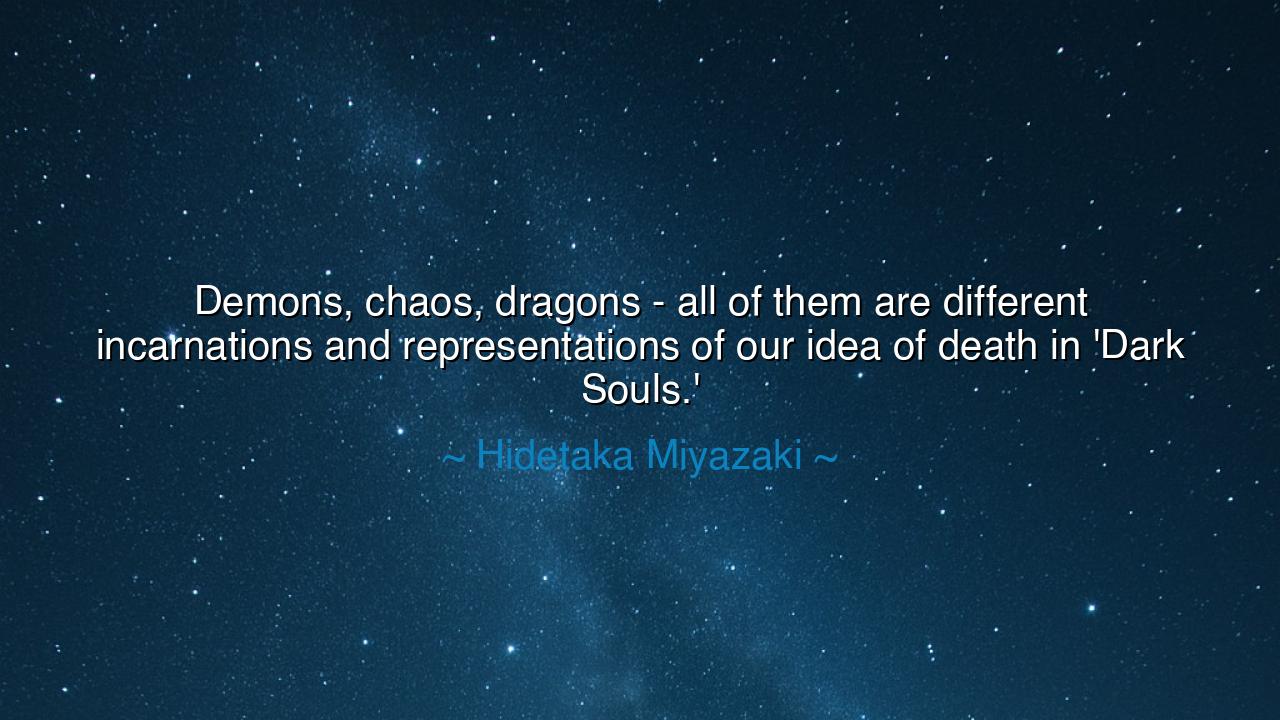
Demons, chaos, dragons - all of them are different incarnations
Demons, chaos, dragons - all of them are different incarnations and representations of our idea of death in 'Dark Souls.'






“Demons, chaos, dragons — all of them are different incarnations and representations of our idea of death in Dark Souls.” Thus spoke Hidetaka Miyazaki, the creator of one of the most profound works of modern myth. Though his words refer to a world of fantasy, their meaning is as old as humanity itself. For in this reflection lies a timeless truth: that death, in all its forms, is the shadow that gives shape to existence. The demons and dragons, the chaos and decay of Miyazaki’s world — these are not mere monsters of the imagination, but symbols of the fears that dwell in the human heart. His vision is not of destruction, but of understanding; not of despair, but of courage born in the face of the inevitable.
The origin of this quote lies in Miyazaki’s creative philosophy, which blends the mythic imagery of the ancients with the moral struggle of the soul. In his universe, death is not an ending, but a cycle — a test that repeats, teaching the player humility, patience, and perseverance. To the untrained eye, Dark Souls is a world of ruin and hopelessness, where every creature seems bent on ending the fragile flame of life. But to those who look deeper, as the philosopher looks into the dark waters of the soul, there is revelation. Each demon, each dragon, each force of chaos, is a reflection of death itself — not as a single event, but as a force that shapes the living, challenges them, and gives their struggle meaning.
In the myths of old, this idea was known well. The dragons of ancient lore were never just beasts — they were guardians of thresholds, symbols of the unknown, embodiments of mortality’s mystery. To slay a dragon was to face one’s fear of death and emerge reborn. So it is in Miyazaki’s creation: each battle is a ritual confrontation, an echo of the heroic journey that all must take within themselves. The chaos that burns and consumes in his world is not simply evil — it is the raw, untamed power of existence itself, which must be met and mastered. The demons, in their grotesque grandeur, stand as reflections of the inner torments of humankind: greed, pride, despair, and the endless desire to escape the inevitability of death.
We can see this same truth mirrored in the history of our world. Consider Beowulf, the ancient hero who faced the monster Grendel, the dark embodiment of fear and destruction. Though he triumphed, his victory was fleeting, for death awaited him as it awaits all. His final battle against the dragon was not against an enemy, but against fate itself. In that struggle, he found not immortality, but meaning — for by meeting death with courage, he achieved a kind of eternity in memory. Miyazaki’s words, too, remind us that it is not the avoidance of death that makes one strong, but the acceptance of it. To live well is to walk knowingly beside mortality, learning from it without surrendering to fear.
To understand death as Miyazaki does is to see it not as destruction, but as transformation. The fire that fades in Dark Souls — that ever-dying light — is the same fire that burns in every human soul: fragile, yet unyielding. Death takes form in many shapes — sometimes as chaos, sometimes as decay, sometimes as the dragon sleeping within our own hearts — but it is always the same teacher. It tells us: “You are not eternal. Therefore, make meaning.” In this, the worlds of Dark Souls are not desolate, but deeply sacred. They teach what the stoics, monks, and warriors of old once knew — that mortality gives weight to every step, and suffering can forge the soul into something enduring.
Even the chaos that seems to consume all creation has its lesson. It whispers that order and beauty are not born from safety, but from struggle. A soul that has faced ruin and risen again becomes tempered, unbreakable. This is why in Dark Souls, defeat is not failure, but revelation. To die is to learn. To rise is to transcend. The ancients would have called this the “hero’s path” — the eternal dance between creation and destruction, between the living and the dying flame.
So, my seeker of wisdom, take this lesson to heart: do not flee from your demons — face them. When chaos storms within you, walk through it with courage. When the dragon of despair coils around your heart, look it in the eye. For every shadow, every ending, every loss is but another face of the same truth: that life and death are not enemies, but partners in the great design. As Hidetaka Miyazaki teaches through his art, the world may be dark and full of ruin, but the flame still burns. To live bravely in the presence of death — to rise again and again after every fall — is the truest victory a soul can achieve. And when you understand this, you will find, as the heroes of old did, that even in the darkness, you are never truly defeated — only reborn.






AAdministratorAdministrator
Welcome, honored guests. Please leave a comment, we will respond soon